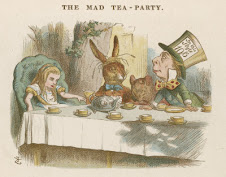In "
The Foundation of Government," from 1776, John Adams wrote:
Fear is the foundation of most governments; but it is so sordid and brutal a passion, and renders men in whose breasts it predominates so stupid and miserable, that Americans will not be likely to approve of any political institution which is founded on it.
Today, fear is among the primary motivations for the continued support of the ruling factions in government. Partisans of the Democratic and Republican parties do not advocate for the candidates of their preferred party but rather call for reactive negation of the candidates of the other major party. To vote for a Democrat is, first and foremost, a vote against the Republican. To vote for a Republican is, first and foremost, a vote against the Democrat. This is the fundamental basis of reactionary, negative politics in the United States today. It is a politics based on fear. It paralyzes voters and ensures the continued joint misrule of the Republican and Democratic parties.
Consider a recent article at
PoliticsUSA laying out "A Possible Nightmare Scenario for America in 2012." The piece takes a look at the possible outcome of a successful or semi-successful third party presidential bid by the candidates of Americans Elect as laid out in an analysis of "the pitfalls of a third party presidential candidacy" published at the
Brookings Institute.
Regular readers will surely be familiar with each of the possible scenarios laid out in the paper. A third party candidate could very well accomplish the impossible and win the presidency. But he or she would then be politically isolated by the partisan composition of the House and Senate. "Few in the House or Senate would feel allegiance to or affinity for the newly elected president," we read at the Brookings Institute. Is this not the very definition of putting party before country? This, in itself, should be reason enough to vote for alternatives to the Democrats and Republicans in the House and Senate. If you are considering a vote for a third party or independent candidate for president, it only makes sense to consider alternatives to the Democrats and Republicans down the ballot.
In the second scenario, the third party candidate receives a modest amount of support, but one of the major party candidates still wins a clear electoral victory but "with diminished popular support. The reduced popular support would undercut the legitimacy of the result
and curtail momentum for the victor." In a country where only around 60% of registered voters turnout for presidential elections, and only 71% of eligible voters are even registered, it is absurd to claim that any president has "popular support." In Barack Obama's "landslide" victory in 2008, he garnered just over 50% support from 60% of 71% of eligible voters. Less than a quarter of eligible voters cast a ballot for Barack Obama in 2008. The partisans of the two-party state would have us believe that this equates to "popular support."
It is the third scenario, however, that scares the author at PoliticsUSA most. In this case, no candidate receives a majority of electoral votes and the election is decided in the US House. From PoliticsUSA:
You see where they are headed with this? Who controls the U.S. House of
Representatives? The extreme right – Tea Party fanatics, demonstrated
nihilists. Who elects the president if this is no clear majority? The
U.S. House of Representatives. . . . Our political system is a mess. . . . But there is real danger in monkeying with the works. People generally
don’t tend to think ahead about the consequences of their actions; we
find out about those later – the hard way. . . . That’s where we are with this potential fix to our ideologically driven
gridlock in Washington. The gridlock is bad. But as the old saying goes,
the cure might be worse than the disease.
Fear raises its ugly head. Sure, our system is a mess, but let's not even try to clean it up. That is the moral to this story. It is noteworthy, given the recent
discussion of centrist strategy here at Politea, that this Democratic commentator holds that Obama is the centrist candidate in 2012: "In 2012 we have a centrist president who steers from the extremes of
either party. If ever there was an awkward time to attempt this [i.e. a centrist third party bid for president], it is
now."







